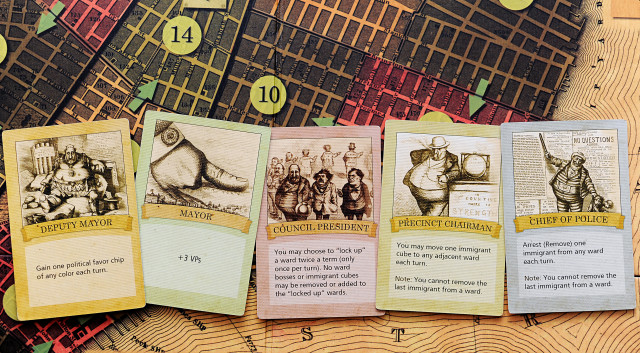I first played Tammany Hall at GenCon in 2012 with Adam, JP and Scott. We had stayed past the closing of the exhibiter hall and gone to the games library room. I remember we were all pretty excited to give it a try. JP and Scott had backed the reprint on Kickstarter and it had been getting lots of great buzz. The biggest thing I remember people saying about Tammany Hall before I first set out to play it was what a ‘mean’ game it is. And why would you expect anything else from a game that asks you to take on the Bill the Butcher role from Gangs of New York and dive into the political fray that was 1870s New York City.
Tammany Hall is a cutthroat area control game with simple rules, but deep decisions to make throughout the game. The board represents lower Manhattan as it would have looked during the time of Boss Tweed. Players fight for political power over sixteen years, trying to control different wards and the different immigrants that populate them. By sending out ward bosses to do their bidding players can get benefits and points from certain wards, slander their opponents and even be elected to higher office.

Each year players will select from a few simple actions. Early on they will only have the option of adding pieces to the board, either two ward bosses or a ward boss and an immigrant cube. Although there was definitely immigrants coming to the US from all over the world at this time, Tammany Hall deals with the four major national groups that held influence, the English, German, Irish and Italians. When you add a ward boss they will help you control the ward in upcoming elections. Adding immigrant cubes allows you to help a national group get into the city from their processing station in the Castle Garden. You can choose what ward the immigrants will settle in and take a political favour chip of that nationality.
After four years an election will be held. In turn each ward will be resolved. Every ward boss counts as one vote for the player. They can also add political favour chips of the different immigrant populations as long as they’re represented in that ward, i.e. I can use German political favour chips as long as there’s German immigrants in that ward. You can mix and match what favour chips you use and it’s a closed hand bid. This is one of the most intense elements of the game. Players must announce how many chips they potentially could use in the election and that’s when the negotiations start. Players may agree to bid nothing, or go all in, but until the hands open and the bids are revealed nothing is set in stone. There’s no obligation to be honest and it’s often not in your best interest.
Players get points for the wards they control and the player who controls the most gets elected Mayor. Before the new year starts the Mayor will give out political offices to all the other players. In future rounds players will now be able to call upon their office for a special benefit. Every four years another election is held and the potential for a new mayor and shifting political offices exists.
Later rounds open up more of the board as the immigrant population moves further north into Manhattan. There is also now the option of Slander. Players can slander an opponent forcing them to remove a ward boss from the board. You must have a ward boss in the same region and spend a political favour chip to spread your salacious rumours about your opponent. Just like gossip taking on a life of its own it’s possible for slander to spill in to an adjacent ward. For another two political favour chips another ward boss can be removed from a ward bordering the first. Just like today, there’s nothing like a good smear campaign to boost your claim to power.

The City Office benefits are nice, but not necessarily game changing. The Mayor gets there points and the right to assign the offices to the other players. The Deputy Mayor takes a political favour of their choice. The Chief of Police can make people disappear by removing an immigrant cube from the board. The Council President can lock up wards not allowing for ward bosses or immigrants to be added or taken away. Finally, the Precinct Chair can move an immigrant cube to an adjacent ward.
After the fourth election the game is over, most points wins. This game feels like a lesson in history class, but not in a boring way. You can literally watch the march of the different immigrant communities as they spread throughout the city. It’s rare to have a game so seamlessly meld game play with historical fact. The board is beautiful and the classic political cartoons on the city office cards is a perfect touch. They really convey the feeling of the political scene in old New York.
This game is not going to be for everyone. The rumours were true, it IS a mean game. Alliances are made and broken at the drop of a hat. Each person is fighting tooth and nail for just one more neighbourhood and they’ll do anything to get it. There’s only so much you can do on each turn, but the ramifications of your decisions reverberate through the rest of the game. Tammany Hall may end the same way Gangs of New York did, with a brutal war. Like I said, not going to be for everyone, but for some people the sound of a tense, historical and political battle is like music to their ears. I would definitely recommend giving it a shot. Just play with people with whom you have a strong friendship…one that can survive a little slander.
Comments
No comments yet! Be the first!